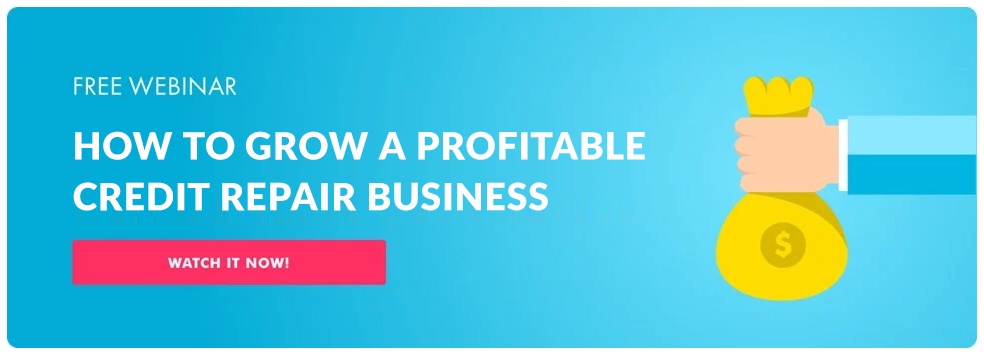 After starting a credit repair business, it’s likely you’ll hit the dreaded stagnation phase. When you first started, your pipeline may have been flooded with new business, but now as you reach six months to a year in business, you’re not sure where or how to find new clients. Or perhaps, your pipeline is full, but you aren’t sure how to scale your business.
After starting a credit repair business, it’s likely you’ll hit the dreaded stagnation phase. When you first started, your pipeline may have been flooded with new business, but now as you reach six months to a year in business, you’re not sure where or how to find new clients. Or perhaps, your pipeline is full, but you aren’t sure how to scale your business.
These conundrums are quite common for credit repair specialists. Read on to learn what it takes to keep growing your credit repair business for years to come.
1. Map a Growth Strategy
If you haven’t already, take the time to develop a growth strategy for your business. A growth strategy should help you understand how to increase business starting with lead generation and ending at customer retention strategies. Consider the following aspects of a comprehensive growth strategy:
Define your target customers
To sell your product more effectively, define your audience based on your experience:
- Since you started your business, what types of customers have expressed interest in your product the most frequently?
- What message will help sell to them strategically?
Many business owners develop three to four personas, or semi-fictional representations of an ideal customer, based on market research and real data to answer these questions. After defining the audience, it’s easier to create a targeted sales pitch to close a higher percentage of deals.
To learn more about persona development, refer to this article.
Create and promote your unique value proposition
A unique value proposition (UVP) is a statement that simply describes:
- The benefit of your product or service
- How your product or service solves a problem for your customers
- What distinguishes your solution from the competition
A unique value proposition will be at the heart of your sales pitch as you begin to spread the word of your new company and grow your client base. As a credit repair business owner, your UVP will depend on what goals your target clients are trying to reach and how you help them do that, better than your competition.For instance, a recent inductee to Credit Repair Cloud’s Millionaire’s Club promoted his business to a niche audience, the Jewish community within a small radius of Brooklyn. This credit repair specialist, Abraham, positioned his business as the only credit repair company in Brooklyn that knew the immediate needs of the Jewish community. This proposition differentiated him from other competitors in the area, which made him valuable to the community who needed specialized attention for their situation.
Find ways to engage your customers
Once you’ve obtained clients, it’s critical to keep them happy and engaged. A solid base of clients allows you to grow your business by adding new leads rather than replacing unhappy clients.
Did you know that it costs five times the amount of money to attract a new customer than retain an existing one?
Engaging your customers means offering terrific customer service, transparency into the work you’re doing, and showing great results.
Find ways to keep clients around longer (and with a higher value)
There are several ways you can shape your business model to keep your customer’s around longer and ensure they continue to spend money with your company. For example, rather than charging clients per deletion, consider shifting your billing cycle to a recurring subscription method. Additionally, you can focus on building an affiliate program where satisfied customers refer you and both of you reap monetary rewards.
By extending a client’s lifetime value, you’re extending the amount of money they spend with your organization.
2. Embrace Outsourcing
Determining how to scale a business creates anxiety for most first-time business owners. By shedding some of your business responsibilities, you can free your time, find less expensive labor than yourself, and reallocate your time and resources toward growth.
Credit repair business software is a great way to streamline business practices and also help assist in the areas of business you don’t specialize in like marketing or lead generation, for example. Credit Repair Cloud’s software helps business owners with tasks like:
- Organizing client communication with a client dashboard
- Coordinating outreach with automated follow-up letters to creditors and credit bureaus
- Generating new leads with a custom credit repair website
If there aren’t pressing reasons for you to handle a task on your own, and you feel comfortable relinquishing some control, outsourcing portions of your credit repair business can help you scale effectively.
3. Invest in Technology

Many credit repair specialists tell us that before starting their credit repair company, they had no idea how large the market was. The pace at which they grew a steady stream of clients caught them off guard. Their lack of preparation made it difficult to understand how to manage all the moving parts at once. You may be experiencing the same drinking-from-a-firehose influx of clients in your new credit repair business.
That’s why it’s critical to invest in technology as you grow your business.
Technology can help business functions like lead generation, time management, and customer service. For example, Credit Repair Cloud’s credit repair software allows professionals to:
- Organize their sales funnel to maximize lead generation
- Set reminders to follow up with clients based on milestones
- Easily pull credit analysis reports with one-click using the Simple Audit Tool
- Manage affiliates for revenue growth
- Access a training portal for continuing education
Often, credit repair specialists start looking for software to help scale and organize their business after they already need it. This can cause unnecessary growing pains and frustration, and it can be difficult to know just what features your credit repair business needs during limited free trials of various software. As you grow your business, invest in the tools that can keep up with your hunger to be successful.
4. Rethink Last Year’s Strategy
Though much of entrepreneurship is learning from mistakes and pivoting as you discover new and better pathways, you don’t have to reinvent the wheel every time. As you’ve learned from your introduction into credit repair, one of the core components of a credit repair business is the ability to write dispute and debt validation letters on a client’s behalf.
Many first-time credit repair business owners fall victim of writing these letters based on speculation, what they think a credit bureau or creditor would like to see included in the letters. While some professionals see a bit of success with this process, it’s worth reexamining your approach this year to help free your time and continue to scale your business.
Credit Repair Cloud compiled a list of battle-tested dispute letter templates to help you go through the process faster, and allow you to take on more clients with higher success rates.
Use the following templates as a guide:
- Goodwill Adjustment Letter
- Disputer Letter to a Credit Bureau
- Dispute Letter to a Collections Agency
- Debt Validation
- Pay for Delete Letter
- Hardship Letter
To learn more about the differences in letters, you can read this resource.
5. Grow Faster This Year
Invest in your business this year to accelerate growth. A few tried-and-true methods for growing a credit repair business include:
- Find a mentor to guide you through your current sticking points; learn what they did to scale their business
- Sign up for a master class to learn the advanced techniques in your industry
- Get a free book that zeros in on scaling a credit repair business effectively
You can also take advantage of Credit Repair Cloud’s free live web training to help you take action today.













